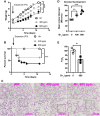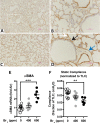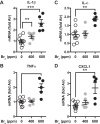Exposure of neonatal mice to bromine impairs their alveolar development and lung function
- PMID: 28912380
- PMCID: PMC5866428
- DOI: 10.1152/ajplung.00315.2017
Exposure of neonatal mice to bromine impairs their alveolar development and lung function
Abstract
The halogen bromine (Br2) is used extensively in industry and stored and transported in large quantities. Its accidental or malicious release into the atmosphere has resulted in significant casualties. The pathophysiology of Br2-induced lung injury has been studied in adult animals, but the consequences of Br2 exposure to the developing lung are completely unknown. We exposed neonatal mouse littermates on postnatal day 3 (P3) to either Br2 at 400 ppm for 30 min (400/30), to Br2 at 600 ppm for 30 min (600/30), or to room air, then returned them to their dams and observed until P14. Mice exposed to Br2 had decreased survival (S) and had decreased weight (W) at P14 in the 400/30 group (S = 63.5%, W = 6.67 ± 0.08) and in the 600/30 group (S = 36.1%, W = 5.13 ± 0.67) as compared with air breathing mice (S = 100%, W = 7.96 ± 0.30). Alveolar development was impaired, as evidenced by increased mean linear intercept at P14. At P14, Br2 exposed mice also exhibited a decrease of arterial partial pressure of oxygen, decreased quasi-static lung compliance, as well as increased alpha smooth muscle actin mRNA and protein and increased mRNA for IL-1β, IL-6, CXCL1, and TNFα. Global gene expression, evaluated by RNA sequencing and Ingenuity Pathway Analysis, revealed persistent abnormalities in gene expression profiles at P14 involving pathways of "formation of lung" and "pulmonary development." The data indicate that Br2 inhalation injury early in life results in severe lung developmental consequences, wherein persistent inflammation and global altered developmental gene expression are likely mechanistic contributors.
Keywords: bronchopulmonary dysplasia; halogen; lung development; lung injury.
Figures




References
-
- Avdalovic MV, Tyler NK, Putney L, Nishio SJ, Quesenberry S, Singh PJ, Miller LA, Schelegle ES, Plopper CG, Vu T, Hyde DM. Ozone exposure during the early postnatal period alters the timing and pattern of alveolar growth and development in nonhuman primates. Anat Rec (Hoboken) 295: 1707–1716, 2012. doi:10.1002/ar.22545. - DOI - PMC - PubMed
-
- Becker LA, Huang B, Bieri G, Ma R, Knowles DA, Jafar-Nejad P, Messing J, Kim HJ, Soriano A, Auburger G, Pulst SM, Taylor JP, Rigo F, Gitler AD. Therapeutic reduction of ataxin-2 extends lifespan and reduces pathology in TDP-43 mice. Nature 544: 367–371, 2017. doi:10.1038/nature22038. - DOI - PMC - PubMed
-
- Buckley RL, Hunter CH, Werth DW, Whiteside MT, Chen K-F, Mazzola CA. A case study of chlorine transport and fate following a large accidental release. Atmos Environ 62: 184–198, 2012. doi:10.1016/j.atmosenv.2012.08.025. - DOI
Publication types
MeSH terms
Substances
Grants and funding
LinkOut - more resources
Full Text Sources
Other Literature Sources
Research Materials

